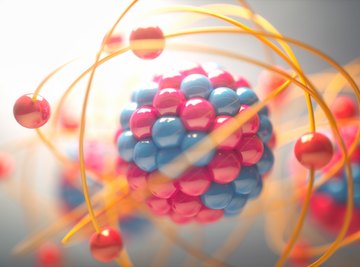
Plants and animals are made up of many smaller units called cells. Each cell has a complex structure that can be viewed under a microscope and contains many even smaller elements called organelles. Plant cells contain some organelles not found in animal cells, such as cell walls and chloroplasts. Each organelle has specific functions in the life and health of the cell, and cell health is important for the well-being of the entire organism.
Nucleus
All plant and animal cells, which are eukaryote organisms, contain a true nucleus bounded by a nuclear membrane. (Prokaryotes such as bacteria and archaea don't have a nucleus.) This structure contains a eukaryotic cell's DNA and directs cell activities.
Endoplasmic reticulum
The cell membrane is double-layered in animals, and forms the outer cell boundary that protects the cell contents and regulates what goes in and out of cells. In plants, a plasma membrane lies just underneath the tough cell wall that supports plant tissue. The endoplasmic reticulum is an extensive membrane complex extending throughout the cytoplasm from the outer membrane of the nuclear envelope. It contains about half of the cell's membranous tissue. Rough endoplasmic reticulum contains ribosomes that produce proteins. Smooth endoplasmic reticulum manufactures lipids.
Golgi Apparatus
Also called the Golgi complex or Golgi body, this organelle looks like a stack of flattened water balloons. It processes the proteins produced by the endoplasmic reticulum and ribosomes, modifying and storing them until it packages them in vesicles. Lysosomes also come from the Golgi apparatus. These are sacs containing enzymes capable of breaking down cell macromolecules.
Storage Organelles
Vesicles are membranous sacs that transport or store a variety of compounds. Produced primarily in the membrane systems of the plasma membrane, endoplasmic reticulum and Golgi apparatus, they move throughout the cell along cytoplasmic filaments to discharge their contents to other organelles or outside the cell. Vacuoles are large in plant cells. One large vacuole takes up much of the cell space and functions in maintaining cell size and turgor pressure (the pressure the cell's contents exert on the wall). Animal cell vacuoles are smaller. They store compounds and help with water and waste regulation.
Energy-Producing Organelles
Mitochondria are peanut-shaped organelles found in both plants and animals. The sites of cellular respiration, they break down sugar to fuel the cell. Chloroplasts occur in plant cells. They contain chlorophylls, and photosynthesis occurs within them, allowing plant cells to form sugar from air and water in the presence of sunlight. Both mitochondria and chloroplasts are thought to have originated from free-living prokaryotic organisms that were engulfed by eukaryotic cells and developed symbiotic relationships with those cells early in the history of life.
Related Topics:
References
About the Author
Carolyn Csanyi began writing in 1973, specializing in topics related to plants, insects and southwestern ecology. Her work has appeared in the "American Midland Naturalist" and Greenwood Press. Csanyi holds a Doctor of Philosophy in biology from the University of Wisconsin at Madison.
